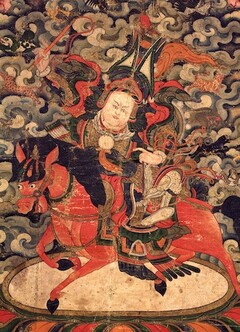Offering Rites to Gesar
Concerning Offering Rites to the Great Lion Gesar
by Jamyang Khyentse Chökyi Lodrö
What follows concerns King Gesar, the great leonine lord and mighty warrior-spirit (dgra lha) of this world.
The Illusory Net of Mañjuśrī says:
With your sword of wisdom and bow and arrows,
You battle and defeat the afflictions and unknowing,
Brave warrior, subduer of demonic forces and foes.
As this indicates, it is the venerable hero Mañjuśrī who manifests in the form of a great warrior-spirit through his enlightened activity of taming in whichever ways are appropriate, just as the bodhisattva Bahuratna appeared as the lord of yakṣas and the tathāgata emanated as a vīṇā player in order to tame the gandharva Pramudita. There are infinite such manifestations of buddhas and bodhisattvas. More specifically, had the demons of Hor not been defeated they would have threatened the security and happiness of the teachings and beings, and this is why Gesar utterly eradicated those hostile forces.
The indications that Gesar was an emanation include the prints left behind by his horse Kyangbu and many other such miraculous signs, universally renowned and still evident in the great northern kingdom and elsewhere.
To put it simply, Gesar is a manifestation of Mañjuśrī; a messenger of Padmasambhava; a dance-like emanation of the activity of the dharma-king Tri Song[detsen]; a great vidyādhara who achieved immortality as a direct disciple of Lang Ami Changchub Dreköl;[1] a warrior-spirit for the whole of Jambudvīpa; a refuge and protector for all practitioners, who is outwardly powerful and inwardly caring; the wealth-keeper of China and Tibet; and the great scourge of foreign armies and invaders.
Now is said to be the time for his enlightened activity, as taught by the treasure-revealer Lharik Dechen Rolpa Tsal,[2] the glorious heruka [Do] Khyentse Yeshe Dorje, Mipham Jampal Gyepa and others, and as expressed in many sādhanas, offering rites and other such texts, which appeared as treasures of enlightened intent. There are also additional offering rites by the lord of the world, the Fourteenth Karmapa, as well as by Jamyang Khyentse Wangpo, Kongtrul Yönten Gyatso and others. Perusing such works will yield at least a partial understanding of this great being's liberational role.
In short, there is no doubt that Gesar is a wisdom emanation of the venerable hero Mañjuśrī—of this we can have complete and boundless certainty.
By Chökyi Lodrö.
| Translated by Adam Pearcey with the generous support of the Khyentse Foundation and Tertön Sogyal Trust, 2020.
Bibliography
Tibetan Edition
'jam dbyangs chos kyi blo gros. "sku rje seng chen rgyal po'i gsol mchod la dpyad pa/" in ’jam dbyangs chos kyi blo gros kyi gsung ’bum. 12 vols. Bir: Khyentse Labrang, 2012. W1KG12986 Vol. 12: 157–158
Secondary Sources
Dilgo Khyentse, Lion of Speech: The Life of Mipham Rinpoche. Translated by Padmakara Translation Group. Boulder, CO: Shambhala Publications, 2020
Forgues, Gregory. "Who Is Gesar? A Textual and Genealogical Investigation of Gesar Rituals and Practices." In The Many Faces of King Gesar: Tibetan and Central Asian Studies in Homage to Rolf A. Stein, ed. Matthew T. Kapstein & Charles Ramble, 199–215. Leiden & Boston: Brill, 2022.
Version: 1.5-20230620
-
rlangs a mi (or a myes) byang chub 'dre bkol. His dates have been given as 968–1076. ↩
-
Gregory Forgues has identified Lharik Dechen Rolpa Tsal as Lha Ganden Tashi Tsering Palbar (lha dga' ldan bkra shis tshe ring dpal 'bar), a contemporary of Shabkar Tsokdruk Rangdrol (zhabs dkar tshogs drug rang grol, 1781–1851). See Forgues, "Who Is Gesar? A Textual and Genealogical Investigation of Gesar Rituals and Practices" pp. 207–208. Note, however, that Dilgo Khyentse Rinpoche placed the figure much earlier, in the seventeenth century. See Dilgo Khyentse, Lion of Speech: The Life of Mipham Rinpoche (Shambhala, 2020): p.208, n.54: "Born in Dhakpo'i Lhagyari, this tertön was the immediately preceding incarnation of Minling Terchen Gyalse Rinchen Namgyal [1694–1758]." ↩
